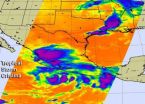(Press-News.org) Lebanon, NH (June 10, 2014) - Dartmouth researchers have found that reducing carbohydrate intake could reduce the risk of breast cancer recurrence among women whose tumor tissue is positive for the IGF-1 receptor. The study, "Risk of Breast Cancer Recurrence Associated with Carbohydrate Intake and Tissue Expression of IGFI Receptor," will appear in the July issue of Cancer Epidemiology Biomarkers & Prevention.
"There is a growing body of research demonstrating associations between obesity, diabetes, and cancer risk," said lead author Jennifer A. Emond, an instructor in the Department of Community and Family Medicine at the Geisel School of Medicine at Dartmouth College. "There are similarities between the biological pathways that underlie all of these conditions, and there is some evidence to suggest that over-activation of the insulin/insulin-like growth factor axis, which increases the availability of IGF1 in the blood, may relate to a poor prognosis among breast cancer survivors."
Receptors for IGF1 have been found in breast tumor tissue, and expression of those receptors may contribute to treatment resistance among breast cancer survivors. Since diet can influence insulin activation, the researchers wondered whether diet could impact breast cancer prognosis based on expression of the IGF1 receptor in the primary breast tumor tissue.
Using an unusual approach, this study assessed the combined association of two factors implicated in tumor growth—carbohydrate intake and IGF1 receptor status—to test whether activating the insulin/insulin-like growth-factor axis can impact breast cancer. Since carbohydrates stimulate the biological pathway that can increase concentrations of IGF1, the researchers focused on carbohydrate intake. The women they studied were part of a larger intervention trial called the Women's Healthy Eating and Living (WHEL) study conducted between 2001 and 2007.
"We found an association between increased breast cancer recurrence in women with a primary breast cancer tumor that was positive for the IGF1 receptor, which is consistent with other studies," said Emond. "We further found that a decreased carbohydrate intake was associated with decreased breast cancer recurrence for these women."
This is the first study to suggest that it might be possible to personalize recommended diets for breast cancer survivors based on the molecular characteristics of their primary tumor. Further research is needed to confirm these findings, and Emond notes that breast cancer survivors should not be concerned about dramatically lowering their carbohydrate intake based on this study.
"There are still many unanswered questions regarding this study, including what type of carbohydrate-containing foods may be the most important foods that breast cancer survivors should limit," she said. "Breast cancer survivors should continue to follow a plant-based dietary pattern as suggested by the American Association for Cancer Research and the American Cancer Association, which means eating lots of fiber rich vegetables, legumes, and fruits; consuming whole grains and also limiting refined grains, starchy vegetables, and added sugar."
INFORMATION:
Co-authors on the study are: Jennifer A. Emond , John P. Pierce , Loki Natarajan , Laarni R. Gapuz , John Nguyen , Barbara A. Parker , Nissi M. Varki, and Ruth E. Patterson. J.P. Pierce, B.A. Parker, L. Natarajan, and J.A. Emond were funded by a donation from the Walton Family Foundation, from National Cancer Institute (CA-69375), and the General Clinical Research Centers, NIH (M01-RR00070, M01-RR00079, and M01-RR00827). J.A. Emond was supported by an Institutional training grant from the National Institute of General Medical Sciences (5 T32-GM084896) and the National Cancer Institute Centers for Transdisciplinary Research on Energetics and Cancer (1U54CA155435-01). L. Natarajan was also partially funded by National Cancer Institute (1R01CA166293-01A1). Finally, J.A. Emond and J.P. Pierce received funding from Ms. Carol Vassiliadis and her family in the form of philanthropic support for these analyses.
About Norris Cotton Cancer Center at Dartmouth-Hitchcock
Norris Cotton Cancer Center combines advanced cancer research at Dartmouth and the Geisel School of Medicine with patient-centered cancer care provided at Dartmouth-Hitchcock Medical Center, at Dartmouth-Hitchcock regional locations in Manchester, Nashua, and Keene, NH, and St. Johnsbury, VT, and at 12 partner hospitals throughout New Hampshire and Vermont. It is one of 41 centers nationwide to earn the National Cancer Institute's "Comprehensive Cancer Center" designation. Learn more about Norris Cotton Cancer Center research, programs, and clinical trials online at cancer.dartmouth.edu.
Limiting carbs could reduce breast cancer recurrence in women with positive IGF1 receptor
2014-06-10
ELSE PRESS RELEASES FROM THIS DATE:
Syracuse University geologists confirm oxygen levels of ancient oceans
2014-06-10
Geologists in the College of Arts and Sciences have discovered a new way to study oxygen levels in the Earth's oldest oceans.
Zunli Lu and Xiaoli Zhou, an assistant professor and Ph.D. student, respectively, in the Department of Earth Sciences, are part of an international team of researchers whose findings have been published by the journal Geology (Geological Society of America, 2014). Their research approach may have important implications for the study of marine ecology and global warming.
"More than 2.5 billion years ago, there was little to no oxygen in the oceans, ...
Lead abatement a wise economic, public health investment
2014-06-10
ANN ARBOR–Childhood lead exposure costs Michigan residents an estimated $330 million annually, and a statewide remediation program to eliminate the source of most lead poisoning would pay for itself in three years, according to a new report.
"Economic Impacts of Lead Exposure and Remediation in Michigan," compares the cost of four well-documented impacts of lead exposure--increased health care, increased crime, increase in special education, and decline in lifetime earnings--with the cost of lead abatement of high-risk homes.
The report is a collaboration between the ...
The whole truth
2014-06-10
CAMBRIDGE, MA -- Children learn a great deal about the world from their own exploration, but they also rely on what adults tell them. Studies have shown that children can figure out when someone is lying to them, but cognitive scientists from MIT recently tackled a subtler question: Can children tell when adults are telling them the truth, but not the whole truth?
Led by Laura Schulz, the Class of 1943 Career Development Associate Professor of Cognitive Science, the researchers found that not only can children make this distinction, but they can also compensate for incomplete ...
Wolves in wolves' clothing not all the same
2014-06-10
New research co-authored by University of Calgary alumna Erin Navid provides evidence that British Columbia's mainland wolves and coastal wolves are more distinct than previously believed.
The research, published today in the scientific journal BMC Ecology, affirms what Chester Starr, an elder from the Heiltsuk First Nation on BC's remote west coast, and his people have always known: 'Timber Wolves' occupy the mainland of the British Columbia coast and 'Coastal Wolves' live on the nearby islands. Starr's insight provided motivation for the study.
"What makes this study ...
Coho salmon: Pinks' and chums' eating cousin
2014-06-10
Newly published research co-authored by scientists at Simon Fraser University and the Raincoast Conservation Foundation shows juvenile coho salmon benefit from dining on the distant remains of their spawning pink and chum cousins.
While juvenile coho salmon feed directly on spawning pink and chum salmon carcasses and eggs, even coho with no direct contact with spawning pink and chum benefit from their nutrient contributions to stream ecosystems.
The new research shows that juvenile coho abundance is up to three times higher in streams with abundant pink and chum compared ...
Genetics reveal that reef corals and their algae live together but evolve independently
2014-06-10
New research reveals that Caribbean corals and the algae that inhabit them form a remarkably stable relationship -- new knowledge that can serve as an important tool in preserving and restoring vital reef-building corals. A scientific paper describing these new findings by a team of marine biologists at Penn State University will be published as a cover article in Molecular Ecology on 10 June 2014.
Coral reefs are important for protecting shorelines, providing seafood, and generating millions of dollars in recreation revenue each year, but rising water temperatures due ...
Miriam Hospital study shows how to make statewide health campaigns more effective
2014-06-10
PROVIDENCE, R.I. - Researchers from The Miriam Hospital have found that adding evidence-based weight loss strategies to a statewide wellness campaign improves weight loss outcomes among participants. The study and its findings are published online in advance of print in the American Journal of Public Health.
Lead researcher Tricia Leahey, Ph.D., and her colleagues chose to conduct a study among participants in Rhode Island's annual, three-month statewide health campaign. Called Shape Up Rhode Island (SURI), the campaign was founded in 2005 and takes a grass roots approach ...
NASA sees Tropical Storm Christina's birth and severe weather in US South
2014-06-10
NASA's Aqua satellite captured a picture of newborn Tropical Storm Cristina on June 10, marking the birth date of the Eastern Pacific Ocean's third tropical storm of the season. The same image showed the severe weather affecting the south central U.S.
Although not at the coastline, the National Hurricane Center said that Cristina is near enough to cause dangerous surf conditions.
According to the National Hurricane Center (NHC), swells generated by Cristina are affecting portions of the south-central coast of western Mexico. These swells will likely continue through ...
NASA-NOAA's Suomi NPP satellite spots Arabian Sea tropical cyclone
2014-06-10
Tropical Cyclone 02A formed in the Arabian Sea as NASA-NOAA's Suomi NPP satellite passed overhead and captured a visible photo of the storm, spotting strongest storms south of its center.
On June 10 at 08:21 UTC (4:21 a.m. EDT), when Suomi NPP passed over 02A, the Visible Infrared Imaging Radiometer Suite (VIIRS) instrument aboard captured a visible image of the storm. VIIRS collects visible and infrared imagery and global observations of land, atmosphere, cryosphere and oceans.
In the image, Tropical Storm 02A appeared slightly elongated but satellite data shows that ...
NASA's SDO sees a summer solar flare
2014-06-10
The sun emitted a significant solar flare, peaking at 7:42 a.m. EDT on June 10, 2014. NASA's Solar Dynamics Observatory – which typically observes the entire sun 24 hours a day -- captured images of the flare.
Solar flares are powerful bursts of radiation. Harmful radiation from a flare cannot pass through Earth's atmosphere to physically affect humans on the ground. However, when intense enough, they can disturb the atmosphere in the layer where GPS and communications signals travel.
To see how this event may affect Earth, please visit NOAA's Space Weather Prediction ...






